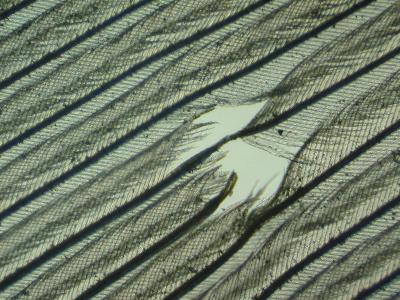Feather Holes on:
[Wikipedia]
[Google]
[Amazon]
 Feather holes often characteristically occur on wing and tail
Feather holes often characteristically occur on wing and tail
 Feather holes often characteristically occur on wing and tail
Feather holes often characteristically occur on wing and tail feather
Feathers are epidermal growths that form a distinctive outer covering, or plumage, on both avian (bird) and some non-avian dinosaurs and other archosaurs. They are the most complex integumentary structures found in vertebrates and an exa ...
s of some small-bodied species of passerines. In the case of barn swallows, it was suggested that the holes were feeding traces of avian lice
Louse (: lice) is the common name for any member of the infraorder Phthiraptera, which contains nearly 5,000 species of wingless parasitic insects. Phthiraptera was previously recognized as an order, until a 2021 genetic study determined th ...
, either '' Machaerilaemus malleus'' and/or '' Myrsidea rustica'' (both Phthiraptera
Louse (: lice) is the common name for any member of the infraorder Phthiraptera, which contains nearly 5,000 species of wingless parasitic insects. Phthiraptera was previously recognized as an order, until a 2021 genetic study determined that ...
: Amblycera).
Hole counts were shown to be highly repeatable, and thus counts appeared to be useful measures to quantify the intensity of infestation. Since then, a number of influential papers have been published on the evolutionary, ecological, and behavioral aspects of host-parasite interactions based on the assumption that holes were chewed by ''Machaerilaemus malleus''. More specifically, host sexual selection, feather breakage, flight performance, immunity levels, arrival dates, and even song characteristics were shown to covary with the number of holes. Cross-fostering experiments showed that infestation levels were heritable.
Recently, however, it was shown that ''Machaerilaemus malleus'' is apparently absent from Europe, where all these studies were carried out. Correlational evidence supports the hypothesis that feather holes are feeding traces of lice, however, the occurrence of '' Brueelia'' spp. lice (Phthiraptera
Louse (: lice) is the common name for any member of the infraorder Phthiraptera, which contains nearly 5,000 species of wingless parasitic insects. Phthiraptera was previously recognized as an order, until a 2021 genetic study determined that ...
: Ischnocera
Ischnocera is a large parvorder of lice from the infraorder Phthiraptera. The parvorder consists of Mallophaga, chewing lice, which feed on the feathers and skin debris of birds. Many species of Ischnocera have evolved an elongated body shape. T ...
) provides the best fit to the distribution and abundance of feather holes both in barn swallows and across several small passerines.
References
{{DEFAULTSORT:Feather Holes Feathers Parasites of birds Lice